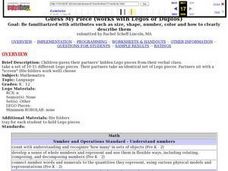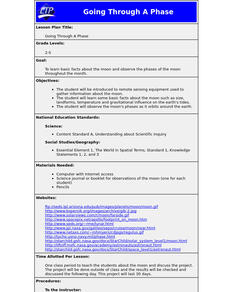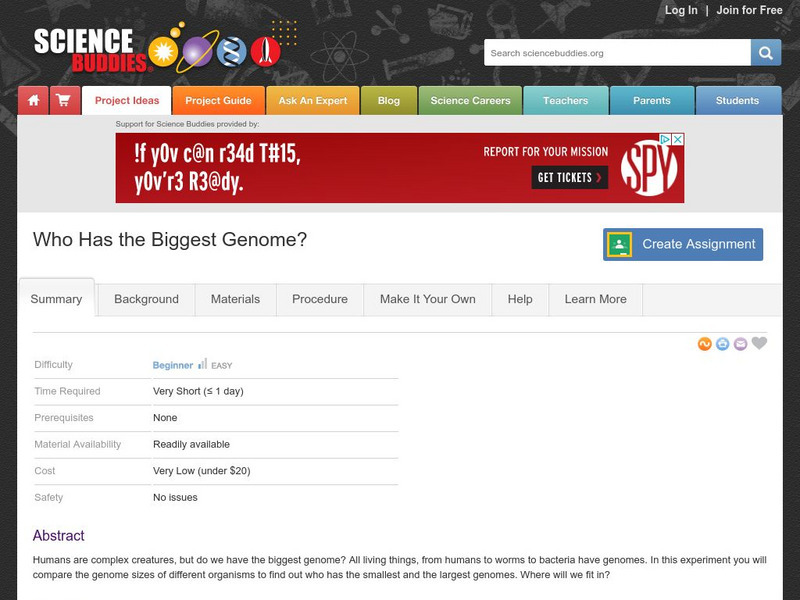Curated OER
Snowflake Fun
In this snowflakes fun worksheet, students identify and read about 5 different snowflakes illustrated on the sheet. First, they cut out each of the snowflakes on the rectangles where indicated to make finger puppets. Then, students use...
Curated OER
Color the Biggest Fish
In this visual discrimination worksheet, students will analyze the sizes of the fish. Students will study five sets of fish and color that fish which is the biggest.
Curated OER
Creating and Designing a Database of Class Library Books
Students are shown how to create their own database using different field types. They are taugt how to design their own layout-chaning font or size and color of text, adding background color and clipart. Students interrogate their...
Curated OER
Guess My Piece -working with Legos
Students participate in guessing their partners' hidden Lego pieces from their verbal clues. They work in partners to accomplish their goals. They are meeting a variety of math standards by completing this instructional activity.
Curated OER
Hudson Canyon Expedition Let's Bet on Sediments!
Learners investigate and analyze the patterns of sedimentation in the Hudson Canyon students observe how heavier particles sink faster than finer particles. They study that submarine landslides (trench slope failure) are
Curated OER
Dog Salmon Lesson Three
Students observe patterns and scale sizes on the salmon skin. They explore the tanning of salmon skills and practice the Athabascan terms for the salmon parts. They make salmon skin prints.
Curated OER
Relative Size: Big and Little
Young scholars work with big and little objects by placing objects in order small to large, and by completing a worksheet.
Curated OER
IS A BLUE WHALE THE BIGGEST THING THERE IS?
First graders explore measurement in relation to size of objects.
Curated OER
Going Through A Phase
Young scholars are introduced to remote sensing equipment used to gather information about the moon. They learn basic facts about the moon such as size, landforms, temperature and gravitational influence on the earth's tides.
PBS
Pbs Learning Media: Amazing Heart Facts
This feature from the NOVA: "Cut to the Heart" highlights facts about the heart, including its size and placement, and will help you to understand the importance of this wondrous organ in our bodies.
Science Buddies
Science Buddies: Who Has the Biggest Genome?
Humans are complex creatures, but do we have the biggest genome? All living things, from humans to worms to bacteria have genomes. In this experiment you will compare the genome sizes of different organisms to find out who has the...
Other
Nikon Corporation: Feel Nikon: Universcale
Amazing site examines size from the most elementary particle to the extremities of space, and everything in between. This interactive feature will encourage you to look differently at your size in relation to the rest of the universe.
Museum of Science
The Atom's Family: Radiometer
Help Dracula find out about light waves by using a virtual radiometer.
Other
The Alphabet of Art: The Attributes
An informative site explaining the attributes of art as well as other art terms.
Discovery Education
Discovery Education: Hope Depot: Science Fair Central
Find advice on project ideas, project steps, presentation tips, classroom activities and more.
Purple Math
Purplemath: Adding and Subtracting Matrices
Demonstrates how to add and subtract matrices, explains why the addition or subtraction sometimes can't be done, and gives an example of how matrix addition is used in homework problems.
Art Institute of Chicago
Art Institute of Chicago: Art Access: African American Art
The Art Institute of Chicago's collection of African American art provides a rich introduction to over 100 years of noted achievements in painting, sculpture, and printmaking. Ranging chronologically from the Civil War era to the Harlem...
Discovery Education
Discovery Education: Stories From Africa
At the end of this lesson, students will have a better understanding of the size of the African elephant. This could be used in an animal science unit, a measuring unit in math, an extension to literature, or for social studies...
Stanford University
Stanford University: How Big Is It?
Lesson provides an activity that introduces the nanoscale using the metric system.
CK-12 Foundation
Ck 12: Life Science: 12.5 Population Growth Limits
Discover how ecosystems respond to population growth limits.
PBS
Pbs Learning Media: Spin a Spiral Galaxy
This interactive activity from NOVA Online lets you spin a spiral galaxy, including our own Milky Way. It demonstrates that what you can learn from visible light observations of a galaxy is largely determined by the angle from which you...
ArtLex
Art Lex: Aerial Perspective
A definition of aerial perspective with examples and links to paintings that use the technique.
Museum of Science
The Atom's Family: The Phantom's Portrait Parlor
In this activity, students investigate the atomic world by attempting to reduce paper to the size of an atom. Although students won't be able to cut the paper that small, they will gain a better understanding of how small the atom is.
















